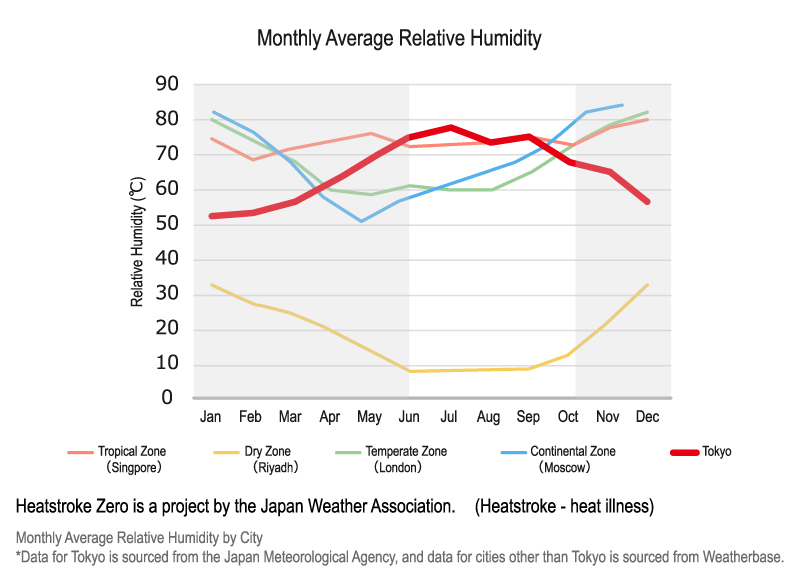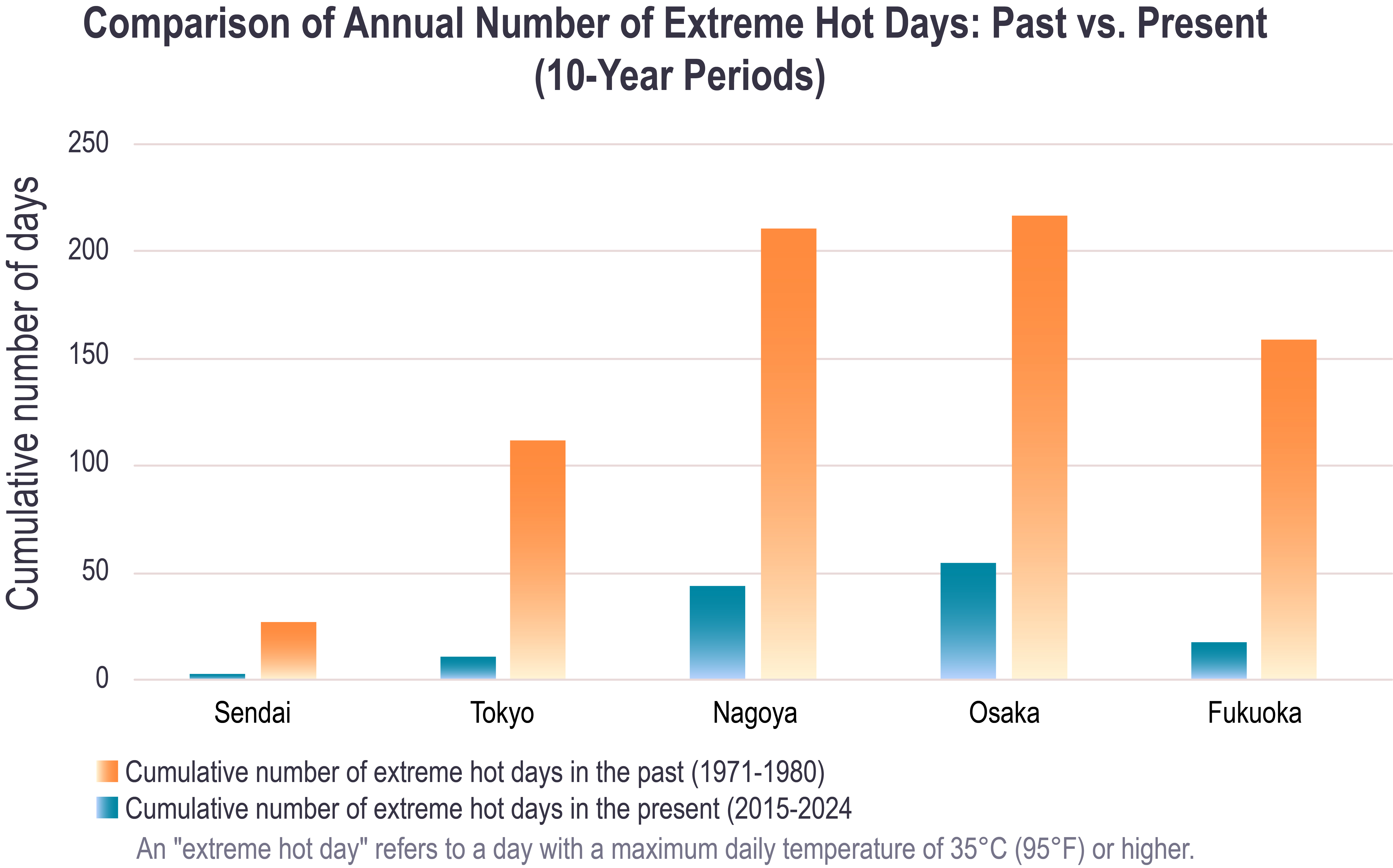News
Summer Weather in Japan: What Global Businesses Need to Know (Beyond Travel Tips)
2025.07.31
When you search for “summer weather in Japan,” most results are aimed at tourists. However, for companies operating in Japan, it is essential to understand the country’s distinctive summer weather risks such as extreme heat and severe storms, that can directly impact on business operations.
This article outlines the key characteristics and risks of Japan’s summer climate from a business perspective, and explains how weather data can be effectively utilized as a countermeasure.
Key Points of This Article
- Japan’s summer is characterized by high temperatures and high humidity, and poses multiple weather-related risks including heatstroke, typhoons, and localized torrential rainfall. In recent years, the effects of climate change have become more pronounced, therefore, relying solely on experience or conventional practices may no longer be sufficient for businesses.
- These summer weather risks can have a direct impact on safety, business continuity, and profitability. Therefore, it is crucial for companies to utilize highly accurate, localized weather information tailored to Japan’s unique topography and climate in operations.
- Japan Weather Association continuously hones its forecasting technologies to address Japan’s unique and diverse weather conditions, offering solutions tailored to various industries.
For more information on the weather complexities in other seasons, please visit:
Why Is Japan’s Weather So Difficult to Forecast?
For the 2024 accuracy verification results of JWA Blend of Models:
2024 Japan Weather Association’s Forecast Accuracy Verification Results
1. Introduction: What is Summer Like in Japan?
1-1. Characteristics of Summer in Japan
Extreme Heat and Humidity, High Perceived Temperature
Japan’s full-fledged summer begins after the rainy season, which typically lasts about a month and a half from May through late June.
One of the most distinctive features of Japan’s summer is its high temperature and high humidity. Daytime temperatures often exceed 30°C (86°F) for several consecutive days, and in some regions, extreme hot days*, with temperatures reaching 35°C (95°F) or higher are common.
Humidity levels are also very high; In Tokyo, for example, the average relative humidity during summer is around 75%. High temperature and high humidity significantly raise the perceived (or “feels like”) temperature, making it feel even hotter than what the thermometer indicates.
* In this article, an “extreme hot day” refers to a day when the maximum temperature reaches 35°C (95°F) or higher, which the Japan Meteorological Agency defines as “moushobi”.
Tropical Nights
In major metropolitan areas such as Tokyo, Osaka, and Nagoya, the urban heat island effect, where urban temperatures remain higher than in surrounding areas, has become increasingly pronounced.
This phenomenon is driven by factors such as the prevalence of artificial surfaces, like asphalt and concrete, as well as artificial heat generated by human activities in urban areas. These materials tend to absorb sunlight and retain significant amounts of heat during the day, while they have the characteristics of not releasing heat efficiently. In addition, poor ventilation and reduced radiative cooling in dense urban structures further prevent temperatures from dropping even at night. As a result, “tropical nights,” where the minimum temperature remains above 25°C (77°F), occur frequently in urban areas.
Typhoon Season
One of the defining aspects of summer in Japan is the frequent occurrence of localized heavy rainfall. Strong sunlight, high humidity, and the influence of the country’s terrain make it easy for powerful updrafts to form, and rapid development of cumulonimbus clouds often leads to sudden downpours.
Localized Torrential Rainfall
One defining feature of Japan’s summer is that it is also typhoon season. Typhoons bring widespread strong winds and heavy rainfall, which can severely affect logistics, infrastructure, and business operations. Typhoons will be discussed in a separate article.
1-2. Comparison with Other Countries: How Severe Is Summer in Tokyo?
When comparing summer temperatures and humidity levels between Tokyo and cities in other climate zones, Tokyo shows levels of heat and humidity equal to or even exceeding those of tropical zone such as Singapore.


Source:“Heatstroke Zero” – Heatstroke Zero Research Report: Survey on “Japan’s Summer Heat” Among Foreign Residents in Japan, Part 1 (Only Available in Japanese)
1-3. Meteorological Mechanism: Why Is Japan’s Summer So Hot and Humid, with Frequent Localized Downpours and Typhoons?
The primary reason Japan’s summer is so hot and humid lies in the influence of two major high-pressure systems: the Pacific High and the Tibetan High.
The Pacific High is a surface high-pressure system that develops over the southern seas of Japan. During summer, it expands northward toward Japan, bringing in warm, humid air. This leads to prolonged periods of clear skies, high humidity, and hot, muggy conditions.
In addition, the Tibetan High in the upper atmosphere can extend toward Japan due to the meandering of the westerlies. When Japan is simultaneously under both systems, it falls within a “tall” high-pressure zone stretching from the surface to the upper atmosphere. Strong downward air currents suppress cloud formation and result in continued clear skies, making it more likely for extremely hot days and tropical nights to persist.
Moreover, when moist air flowing from the south collides with mountainous terrain or localized updrafts, cumulonimbus clouds rapidly develop, resulting in localized torrential rainfall.
On top of that, typhoons tend to approach Japan from summer into autumn, often riding along the periphery of the Pacific High.
In short, summer weather in Japan is strongly influenced by high-pressure systems and atmospheric circulation, making it prone to a combination of distinctive weather patterns, including extreme heat, high humidity, localized torrential rainfall, and frequent typhoons.
2. Understanding Heatstroke and WBGT
2-1. Heatstroke
Heatstroke occurs when the body has difficulty in regulating its internal temperature due to environmental factors such as high temperatures, high humidity, strong sunlight, and low wind speed, leading to an imbalance in fluids and electrolytes in the body. Symptoms range from mild dizziness to severe unconsciousness, and early intervention is essential.
2-2. WBGT
WBGT (Wet Bulb Globe Temperature) is an index calculated based on four key elements: air temperature, humidity, solar radiation/radiant heat, and wind. It is used to assess heat stress on the human body under hot and humid environments and is widely utilized in evaluating the risk of heatstroke.
2-3. Impact on Business
As of June 1, 2025, amendments to Japan’s Industrial Safety and Health Regulations require companies to implement heatstroke prevention measures when work is conducted for a certain period of time in environments where the WBGT exceeds 28°C (82°F) or the temperature exceeds 31°C (87°F).
This regulation mandates that businesses take concrete steps to protect workers from heat-related risks, particularly during Japan’s increasingly hot and humid summers.
Details: “From June 1, Heatstroke Prevention Measures Become Mandatory in Workplaces – Required Actions and Use of WBGT” (Only Available in Japanese)
Heatstroke and rising WBGT levels pose serious challenges not only to worker safety but also to overall business operations. Without proper measures, companies face a range of risks such as occupational accidents, decreased productivity, penalties for non-compliance, disruptions in the supply chain, negative customer experience and declining sales, and reputational damage.
Accurate up-to-date weather data is not just a tool for heat protection, it is a strategic asset that supports business decision-making.
3. Japan’s Changing Climate: More Extreme and Less Predictable
3-1. How Recent Summers Differ from the Past
The average summer temperature in Japan has been on a long-term upward trend, rising by approximately 1.31°C (34°F) per 100 years.
As shown in the graph below, the number of extreme hot days in Tokyo during the recent decade (2015–2024) has increased more than tenfold compared to the period from 1971 to 1980.

3-2. Why is Japan’ Summer Getting Hotter?
Global warming has been driven primarily by increased greenhouse gas emissions from human activities in recent years.
The rise in summer temperatures and the growing number of extreme hot days in Japan are considered to be effects of this global warming.
In fact, the summers of 2023 and 2024 were the hottest on record in Japan. One of the key contributing factors cited is the unusually high sea surface temperatures in the waters near Japan.
4. Leveraging Weather Data for Business
Consumer behavior is highly influenced by daily weather conditions, which can significantly impact the product and service sales.
In Japan, during the hottest period- the third quarter (from July to September), data shows that when the temperature rises by just 1°C (33°F), consumer spending increases by 1.1% to 5.4% per day in commercial facilities, restaurants, and leisure-related sectors*.
* Japan Weather Association analyzes the impact of daily weather conditions on consumer spending by industry, based on statistical data on credit card transactions by store type (Tokyo area, period: 2019-2023), which has been processed to prevent identification of specific individuals or merchants.
For more details: “Analyzing the Social Impact of Weather Using Consumer Statistical Data – Implications for the Hot and Rainy Summer of 2024” (Only Available in Japanese).
Relying solely on last year’s weather data or yearly averages may be insufficient for business decision-making. To succeed in the Japanese market, it is essential to utilize localized weather information tailored to the country’s unique topography and climate.
- Examples of Available Data
- Hourly and daily weather forecasts (temperature, humidity, perceived temperature, etc.)
- WBGT (Wet Bulb Globe Temperature)
- Typhoon activity and heavy rainfall (to be introduced in the next article)
- Weather Data API
- GoStop (information on transportation impact risks)
- Examples of Industry-Specific Applications of Weather Information
- Retail: Use short-term forecasts to adjust and optimize sales strategies and supply-demand balance based on local temperature and precipitation.
- Apparel: Apply long-term forecasts for product planning and promotional scheduling, enabling weather-responsive marketing.
- Food & Beverage: Based on the forecasts provided, fine-tune inventory strategies and promotional schedules in anticipation of high-temperature periods to capture peak demand.
- Agriculture: Monitor local weather risks and utilize weather information to create work plans, pest and disease control measures, and overall farm management.
- Energy: Utilize weather forecasts to evaluate and prepare supply systems and maintenance plans.
- Advertising: Utilize short-term forecasts to deploy timely ad campaigns tailored to weather conditions such as extreme heat.
- Tourism & Hospitality: Leverage weather forecasts to optimize facility operations, staff allocation, and promotional activities..
- Finance & Insurance: Incorporate weather-related risks such as extreme heat into risk assessment and investment decision-making.
- Logistics & Manufacturing: Forecast the impacts of high temperatures and typhoons to optimize transportation routes and production schedules.
- Other Forecasts
- 2-Year Long-Term Weather Forecast
Part 1. What are Long-Term Forecasts? JWA’s Proprietary “2-Year Long-Term Weather Forecast” and Its Business Applications
Part 2. What are Long-Term Forecasts? JWA’s Proprietary “2-Year Long-Term Weather Forecast” and Its Business Applications - Product Demand Forecasting
5. Conclusion:Bringing Weather Intelligence to Your Operations
Japan’s summer presents a combination of risks—including high temperatures, high humidity, typhoons, and torrential rainfall—that affect all aspects of business activity, from consumer behavior and logistics to store management.
By utilizing highly accurate, localized forecasts, businesses can reduce costs, mitigate risks, avoid missed opportunities, and ultimately improve overall business performance.Please tell us about your challenges. For inquiries, please visit: Contact Us
- 2-Year Long-Term Weather Forecast